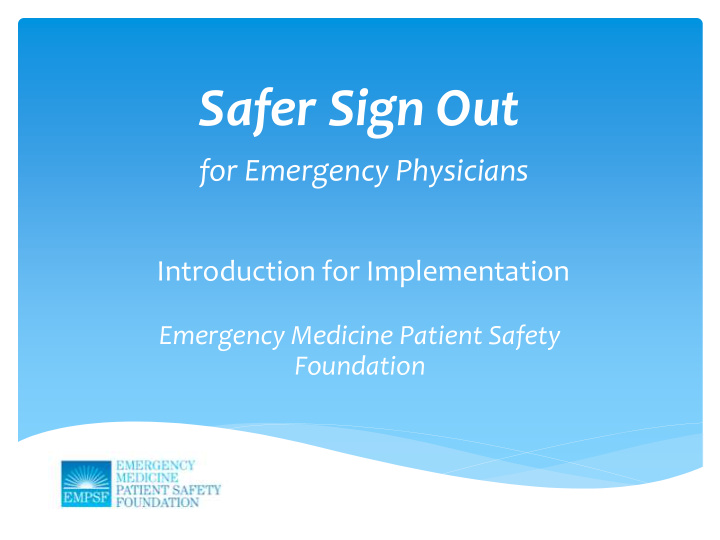



Safer Sign Out for Emergency Physicians Introduction for Implementation Emergency Medicine Patient Safety Foundation
“Sign out is the most dangerous procedure in the Emergency Department” Charles “Chaz” Schoenfeld, MD (1950-2010)
Why Standardize Sign Out ? • High RISK process (Highly variable practice) • Emergency Medicine particular vulnerable • Standardized method • Lower variability & predictable process • Focuses on areas at risk for errors • Joint Commission recommendation (National Patient Safety Goal 2E)
What is Safer Sign Out? • Method for formalizing the patient sign out for ED physicians • Provides a proven, reliable structure for “handing off” ED patients • Developed using recommendations from: • Joint Commission • American College of Emergency Physicians (Quality Improvement & Patient Safety Section) • Expert consensus • Clinician feedback
What’s the Data? Up to 80% of serious medical errors involve miscommunication during handoffs ( Solet et al 2005 ) Up to 24% of ED malpractice claims involve faulty handoffs (Cheung et al 2010 ) Typical verbal with note-taking style handoffs had high rates of data loss (D. Pothier, et al 2005) Written form with verbal exchange = > minimal data loss (D. Pothier, et al 2005)
5 Key Steps - “5 Rs” 1) Record - Patient & essential data / updates / pending items 2) Review - Form & computer data 3) Round – Bedside, together 4) Relay to the Team – Inform the nurse/team 5) Receive Feedback – Clinical Outcome & SSO Feedback
Inform the patient prior to the sign out (if possible) Gives the patient an opportunity to be updated & ask questions May save time for your colleague Potential for an improved transition
Record with a Sign Out Form Hand written or computer generated Identifies the patient Clear transfer of responsibility Prompts physician to identify: • Pertinent active issues • Pending items • Potential safety issues Serves as a checklist, reference & reminder tool
Review the Sign Out Form & Computer Data Done at a computer Access to lab/rad results Purposeful time for Q & A Assures shared understanding Minimize interruptions
Bedside Round - Together “Eyes on the patient” • Patient status • Monitor reading Introduction of new doctor • Patient satisfaction • Process updates Team communication Include or inform the nurse (relay)
Inform the nurse of transition & important updates • Opportunity for nurse input & feedback • Assures team understanding • Done during or after rounds
Utilize the sign out form as a feedback tool Receiving physician records outcome • Patient disposition, updates Form placed in mailbox of off- going physician (if HIPPA Compliant) Copy can be used for monitoring the process/QA
Educational Slide Sets Educational Posters Sign Out Forms FAQs Tools for ABEM MOC use Educational Videos (pending)
Quality Improvement & Patient Safety Section Website First Featured Safety Project
• Build the case for standardizing • Download tools from ACEP QIPS • Enlist “Champions” to assist • Be clear on expectations • Be consistent with utilization “All active ED Patients” Encourage Team based approach Include the nurse Monitor the process
Initial Safer Sign Out Sites Calvert Memorial Hospital, Prince Frederick, MD Carroll Hospital Center, Westminster, MD Civista Medical Center, La Plata, MD Washington Adventist Hospital, Takoma Park, MD Montgomery General Hospital, Olney, MD Sibley Memorial Hospital, Washington, DC Inova Alexandria Hospital, Alexandria, VA Prince William Hospital, Manassas, VA Reston Hospital Center, Reston, VA Virginia Hospital Center, Arlington, VA Heathcote Health Center, Haymarket, VA Jefferson Memorial Hospital, WVA
SSO Development Team Don Infeld, MD (President) Jackie Pollock, CEO Justin Green, MD Nicole Bergen, Dir. of Operations Napoleon Magpantay, MD Martin Brown, MD, (CMO) Kurt Rodney, MD John Schnabel, MD Sora Chung, MD Tim Hsu, MD Matt Sasser, MD Richard Ferraro, MD Jon D’Souza, MD Karla Lacayo, MD Todd Larson, MD Cameron Cushing, MD Junior Williams, MD Michael Kerr, MD Larry Mack-Wilson, PA-C Steven Smith, MD Eric Parvis, MD David Jacobs, MD Jennifer Abele, MD Drew Fuller, MD, MPH Drew White, MD, MBA Kilole Kanno, MD Michael Silverman, MD
Dickson Cheung, Jack Kelly and the ACEP QIPS working group on Improving Handoffs Emergency Medicine Associates, PA, PC Germantown, Maryland EMA Safety Leadership Group Physicians and Leadership at Calvert Memorial Hospital Prince Fredrick, Maryland
Further Information Drew Fuller, MD, MPH, FACEP Strategic Coordinator for Patient Safety Emergency Medicine Associates, PA, PC 20010 Century Blvd, Suite 200 Germantown, Maryland 20874 Drewfuller@mac.com
Recommend
More recommend